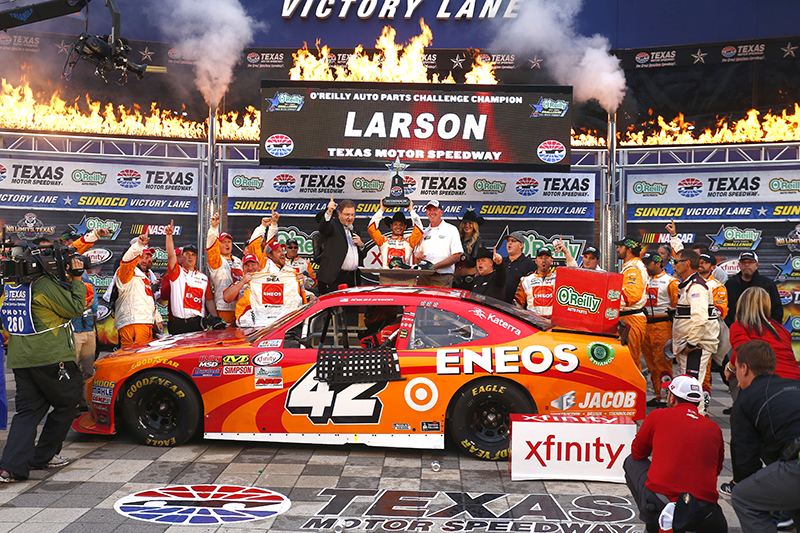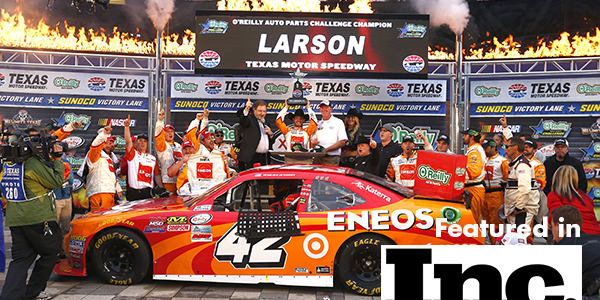
Kyle Larson in victory lane at Texas Motor Speedway. CREDIT: Action Sports Photography
Nascar driver Kyle Larson and lubrication manufacturer ENEOS serve as a great model for companies hoping to partner with a ambassador to help publicize, market, and position their brands.
By Jeff Haden @jeff_haden
Many businesses — big and small — hope that partnering with brand ambassadors will help publicize and market their brands.
Unfortunately that partnership doesn’t always go as planned.
When I talked with Bodybuilding.com CEO Richard Jalichandra, he said, “The number one rule is authenticity. For an association to work, it has to be authentic. And even then it still might not work. For every celebrity association that seems to be a magic bullet… fifteen others have failed.”
Since then I’ve noticed a number of instances where that association doesn’t work, resulting in a loss of money, time, and brand positioning for the business involved.
And then I found one that works because it is based on authenticity; only then did other considerations come into play.
On one side is ENEOS, the brand of lubrication products manufactured and sold by JX Nippon Oil & Energy, the largest oil company in Japan. While still in the early stages of developing its consumer footprint in the U.S., ENEOS is the leading “factory fill” (meaning the lubricants installed in new cars when they leave the factory) for Toyota, Nissan, Honda, and Hyundai.
On the other side is Kyle Larson, driver of the No. 42 car for Chip Ganassi Racing in Nascar’s Sprint Cup Series. (Kyle also drives in select races in the Xfinity Series and owns a sprint car team with Justin Marks, an entrepreneur driver I profiled here.)
The partnership makes sense: Both ENEOS and Larson are emerging brands in the U.S. and in Nascar: ENEOS has enjoyed steady growth, and Kyle won his first Sprint Cup race earlier this year, and also qualified for Nascar’s Chase (championship playoff).
And being involved in racing certainly makes sense for ENEOS since it’s a performance brand.
“The motor oil is very mature and saturated,” says a marketing representative from JX Nippon. “Our challenge is to build awareness and gain business. We chose motor sports because motor oil is a natural connection for motorsports and fans, and our business partners are heavily involved.
“We also want to communicate our technology capabilities and focus on performance focus. Racing is the perfect way to build awareness because race fans are naturally interested in performance.”
In racing, sponsorship can be as simple as just picking a famous driver or team and writing a check. ENEOS wanted to do something more, seeking partner with drivers and teams that can help tell the brand’s story and not just serve as rolling billboards.
“Kyle has a very interesting background,” the rep says. “His Japanese heritage is a bonus for us (Kyle is the only Nascar driver of Japanese descent). He’s a relatively new driver with growing success, and we wanted to be associated with someone that is up-and-coming because that’s how we see our brand in the U.S.
“And on a personal level he’s very relatable and humble and approachable. In the last few years he’s had great success and he’s letting us take advantage of his success. Our partnership is going great in large part because we have a very good fit at the personal level.”
For Larson the partnership works at a personal level as well. “In 2014 they were on my car for two races,” Kyle says, “and we won the first race with them in Charlotte that May. Our relationship has definitely grown since then. Then this past December I went to Japan for the first time. It was a neat experience to see their culture, see Tokyo, and meet a lot of people at JX Nippon.”
“A lot of things were new to Kyle,” the JX Nippon rep says. “We took the group to the fish market but Kyle doesn’t eat fish, so he had lunch at the spaghetti house inside the market.”
The partnership also works because it fits strategically within ENEOS’s marketing plans and budget. The overarching strategy is to play to the company’s strength as a factory fill supplier and its R&D investments in racing and street technology and product quality.
“Branding has to work with sales,” the rep says. “U.S. sales are a fraction of overall company sales, and we don’t have huge marketing resources to work with, so we defined the segment where we have the greatest opportunity to make an impact and make inroads and win. Little wins give us the chance to move into other areas.”
“Wins” also include on-track performance, an external pressure that Kyle is definitely used to. “My whole racing career,” Kyle says, “we’ve grown up with sponsors and at an early age you know you need to both perform and in public represent your sponsors well. Drivers grow up knowing it’s our job to do everything we can to get results on the track and help our sponsors off the track. That’s just part of our sport.”
And to Larson, that’s a positive aspect to the sport.
“When people see ENEOS on the street, at a store, on the shelves, and on our car,” Kyle says, “they think of racing … and they think of me. I like that. And it’s up to us to work hard to represent them the best we can.
“On the flip side, it’s fun at the track. ENEOS employees are big race fans and they come the races and have a great time. To me that’s an important consideration for companies thinking about sponsoring a race team or partnering with a brand ambassador: you have to enjoy the sport. You have to enjoy what that person does. That’s key to having a successful relationship, because it only works if it’s fun and meaningful for everyone involved.”
But more than anything, a successful brand ambassador relationship has to make sense in the mind of customers. People can instantly tell when a partnership feels forced or artificial.
“Authenticity is everything for a brand like us,” the JX Nippon rep says. “We’re still in the stage where we need to build our brand. So we rely very much on stories. We believe stories are the best way we can differentiate ourselves from other brands.
“Because Kyle has a great story, and in many ways his story is like ours, that makes him a great partner and this a great sponsorship opportunity.”
If you’re considering partnering with a brand ambassadorship, make sure that relationship is authentic, is natural, and benefits both parties — because when it does, you’ll each work harder to advance each other’s interests … and by extension, your own.
This article originally appeared on November 16, 2016 on Inc.com.

